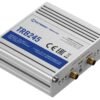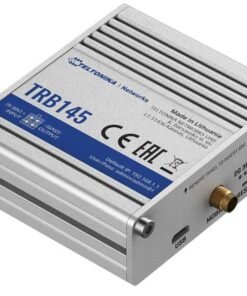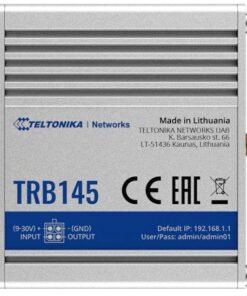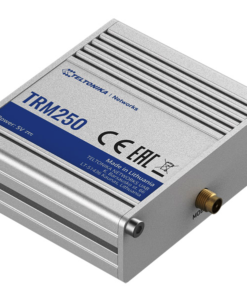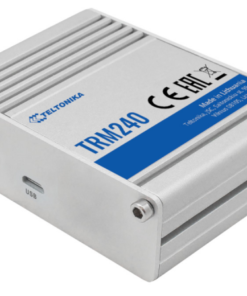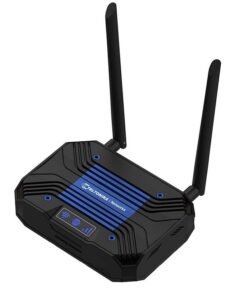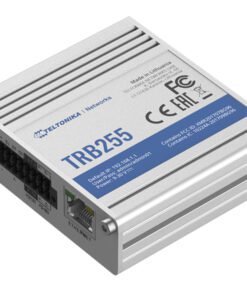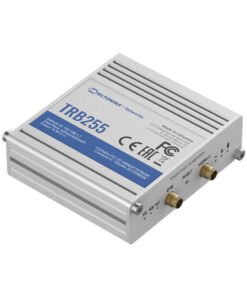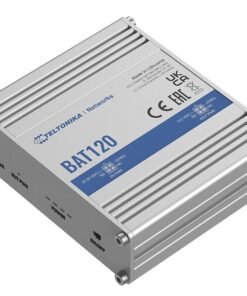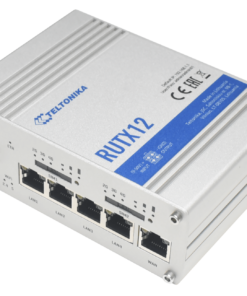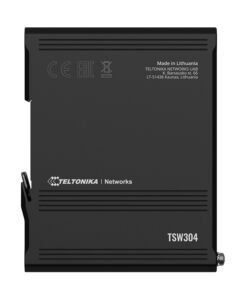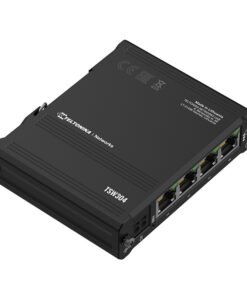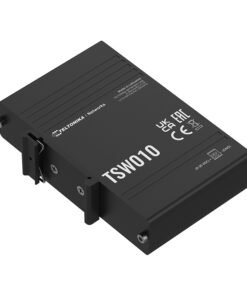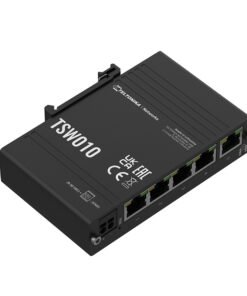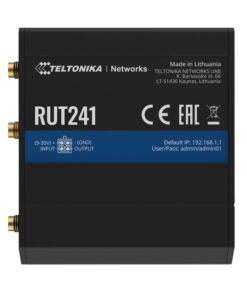TRB145 Industrial Rugged LTE RS485 Gateway 4G/LTE (Cat 1), 3G, 2G
€103.00 excl VAT
The Teltonika TRB145 is a small, rugged industrial LTE & IoT gateway including a metal housing and :
- Mission-critical LTE
- Compact LTE Gateway
- RS485 interface
- Ideal for RS485 remote control
- Security Features
TRB145 Industrial Rugged LTE is the IoT gateway that is both reliable and energy efficient. This gateway can easily help you manage industrial equipment efficiently and remotely. To get everything perfectly going, TBR 145 is the most justified option.
It is not only small and light in weight, but it also provides mission-critical LTE connectivity. Furthermore, there is also an RS485 interface that helps you remotely manage the industrial equipment.
Key Features of TRB145 Industrial Rugged LTE:
TBR 145 is one of the best IoT gateways. Below are the features of TBR 145:
Connectivity:
With the help of TBR 145, you will get a consistent connectivity option of 4G/LTE (Cat 1), 3G, and 2G. You can stay connected to your equipment no matter where you are. Even it works in remote positions as well.
Compact Design:
TRB145 Industrial Rugged LTE is not only the best connectivity option but is also quite compact design. It is easy to install and also maintain. Moreover, you will not need to allocate too much space or worry about finding an ideal location for your device connectivity.
Efficient Remote Management:
You can also efficiently manage your equipment because it has an RS485 interface. Furthermore, you can remotely manage and monitor the status of the devices without the help of manual intervention. It will definitely save the money and time of yours.
Protocols:
TBR 145 is also Compatible with Common Communication Standards. The compatibility for protocols includes DNP3 and Modbus. So you can easily integrate into the existing industrial systems.
MOBILE
-
Mobile module: 4G (LTE) – Cat 1 up to 10 Mbps, 3G – Up to 42 Mbps, 2G – Up to 236.8 kbps
-
Status: Signal strength (RSSI), SINR, RSRP, RSRQ, EC/IO, RSCP, Bytes sent/received, connected band, IMSI, ICCID
-
SMS: SMS status, SMS configuration, send/read SMS via HTTP POST/GET, EMAIL to SMS, SMS to EMAIL, SMS to HTTP, SMS to SMS, scheduled SMS, SMS autoreply, SMPP
-
USSD: Supports sending and reading Unstructured Supplementary Service Data messages
-
Black/White list: Operator black/white list
-
Multiple PDN: Possibility to use different PDNs for multiple network access and services
-
Band management: Band lock, Used band status display
-
APN: Auto APN
-
Bridge: Direct connection (bridge) between mobile ISP and device on LAN
-
Passthrough: Router assigns its mobile WAN IP address to another device on LAN
NETWORK
-
Routing: Static routing
-
Network protocols: TCP, UDP, IPv4, IPv6, ICMP, NTP, DNS, HTTP, HTTPS, FTP, SMTP, SSL v3, TLS, ARP, VRRP, PPP, PPPoE, UPNP, SSH, DHCP, Telnet, SMPP, SMNP, MQTT
-
VoIP passthrough support: H.323 and SIP-alg protocol NAT helpers, allowing proper routing of VoIP packets
-
Connection monitoring: Ping Reboot, Wget Reboot, Periodic Reboot, LCP and ICMP for link inspection
-
Firewall: Port forward, traffic rules, custom rules
-
DHCP: Static and dynamic IP allocation, DHCP Relay, Relayd
-
QoS / Smart Queue Management (SQM): Traffic priority queuing by source/destination, service, protocol or port, WMM, 802.11e
-
DDNS: Supported >25 service providers, others can be configured manually
-
Network backup: Mobile, VRRP, Wired options, each of which can be used as an automatic Failover
-
SSHFS: Possibility to mount remote file system via SSH protocol
-
Authentication: Pre-shared key, digital certificates, X.509 certificates
-
Firewall: Pre-configured firewall rules can be enabled via WebUI, unlimited firewall configuration via CLI; DMZ; NAT; NAT-T
-
Attack prevention: DDOS prevention (SYN flood protection, SSH attack prevention, HTTP/HTTPS attack prevention), port scan prevention (SYN-FIN, SYN-RST, X-mas, NULL flags, FIN scan attacks)
-
VLAN: Port and tag based VLAN separation
-
Mobile quota control: Custom data limits for SIM card
-
WEB filter: Blacklist for blocking out unwanted websites, Whitelist for specifying allowed sites only
-
Access control: Flexible access control of TCP, UDP, ICMP packets, MAC address filter
VPN
-
OpenVPN: Multiple clients and a server can run simultaneously, 12 encryption methods
-
OpenVPN Encryption: DES-CBC, RC2-CBC, DES-EDE-CBC, DES-EDE3-CBC, DESX-CBC, BF-CBC, RC2-40-CBC, CAST5-CBC, RC2-64-CBC, AES-128-CBC, AES-192-CBC, AES-256-CBC
-
IPsec: IKEv1, IKEv2, with 5 encryption methods for IPsec (DES, 3DES, AES128, AES192, AES256)
-
GRE: GRE tunnel
-
PPTP, L2TP: Client/Server instances can run simultaneously, L2TPv3 support
-
Stunnel: Proxy designed to add TLS encryption functionality to existing clients and servers without any changes in the program’s code
-
DMVPN: Method of building scalable IPsec VPNs
-
SSTP: SSTP client instance support
-
ZeroTier: ZeroTier VPN client support
-
WireGuard: WireGuard VPN client and server support
-
ID range: Respond to one ID in range [1;255] or any
-
Allow Remote Access: Allow access through WAN
-
Custom registers: MODBUS TCP custom register block requests, which read/write to a file inside the router, and can be used to extend MODBUS TCP Slave functionality
MODBUS TCP MASTER
-
Supported functions: 01, 02, 03, 04, 05, 06, 15, 16
-
Supported data formats: 8 bit: INT, UINT; 16 bit: INT, UINT (MSB or LSB first); 32 bit: float, INT, UINT (ABCD (big-endian), DCBA (little-endian), CDAB, BADC)
-
Supported baud rates: From 300 to 300000
-
Supported functions: 01, 02, 03, 04, 05, 06, 15, 16
-
Supported data formats: 8 bit: INT, UINT; 16 bit: INT, UINT (MSB or LSB first); 32 bit: float, INT, UINT (ABCD (big-endian), DCBA (little-endian), CDAB, BADC), HEX, ASCII
-
Number of data bits: 8
-
Number of stop bits: 1
-
Parity: None, Even, Odd
-
Flow: None, Xon/Xoff
-
Duplex: Half duplex
MODBUS DATA TO SERVER
-
Protocol: HTTP(S), MQTT, Azure MQTT
-
MQTT Gateway: Allows sending commands and receiving data from MODBUS Master through MQTT broker
-
Supported modes: TCP Master, DNP3 Outstation, RTU Master
-
WEB UI: HTTP/HTTPS, status, configuration, FW update, CLI, troubleshoot, event log, system log, kernel log
-
FOTA: Firmware update from server, automatic notification
-
SSH: SSH (v1, v2)
-
SMS: SMS status, SMS configuration, send/read SMS via HTTP POST/GET
-
Call: Reboot, Status, Mobile data on/off, Output on/off, answer/hang-up with a timer
-
TR-069: OpenACS, EasyCwmp, ACSLite, tGem, LibreACS, GenieACS, FreeACS, LibCWMP, Friendly tech, AVSystem
-
MQTT: MQTT Broker, MQTT publisher
-
SNMP: SNMP (v1, v2, v3), SNMP Trap
-
JSON-RPC: Management API over HTTP/HTTPS
-
MODBUS: MODBUS TCP status/control
-
RMS: Teltonika Remote Management System (RMS)
IOT PLATFORMS
-
Cloud of Things: Allows monitoring of: Device data, Mobile data, Network info, Availability
-
ThingWorx: Allows monitoring of: WAN Type, WAN IP, Mobile Operator Name, Mobile Signal Strength, Mobile Network Type
-
Cumulocity: Allows monitoring of: Device Model, Revision and Serial Number, WAN Type and IP, Mobile Cell ID, ICCID, IMEI, Connection Type, Operator, Signal Strength
-
Azure IoT Hub: Can send device IP, Number of bytes send/received, Temperature, PIN count to Azure IoT Hub server, Mobile connection state, Network link state, IMEI, ICCID, Model, Manufacturer, Serial, Revision, IMSI, SIM State, PIN state, GSM signal, WCDMA RSCP, WCDMA EC/IO, LTE RSRP, LTE SINR, LTE RSRQ, CELL ID, Operator, Operator number, Connection type
SYSTEM CHARACTERISTICS
-
CPU: ARM Cortex-A7 1.2 GHz
-
RAM: 128 MB, DDR2
-
FLASH storage: 512 MB, SPI Flash
FIRMWARE / CONFIGURATION
-
WEB UI: Update FW from file, check FW on server, configuration profiles, configuration backup, restore point
-
FOTA: Update FW
-
RMS: Update FW/configuration for multiple devices at once
-
Keep settings: Update FW without losing current configuration
FIRMWARE CUSTOMIZATION
-
Operating system: RutOS (OpenWrt based Linux OS)
-
Supported languages: Busybox shell, Lua, C, C++
-
Development tools: SDK package with build environment provided
-
Configurable I/O: 2 x Configurable Inputs/Outputs. Digital input 0 – 5 V detected as logic low, 8 – 30 V detected as logic high. Open collector output, max output 30 V, 300 mA (Configurable Inputs/Outputs are not available in TRB145*2****)
-
Output control: HTTP POST/GET, Schedule
-
Events: Email, RMS, SMS
-
I/O juggler: Allows to set certain I/O conditions to initiate event
POWER
-
Connector: 4-pin industrial DC power socket
-
Input voltage range: 9 – 30 VDC, reverse polarity protection; surge protection >31 VDC 10us max
-
Power consumption: < 5 W
PHYSICAL INTERFACES (PORTS, LEDS, BUTTONS, SIM)
-
Status LEDs: 3 x connection type status LEDs, 3 x connection strength LEDs, 1x Power LED
-
Status LEDs: 3 x connection type status LEDs, 5 x connection strength LEDs, 1 x Power LED
-
SIM: 1 x SIM slot (Mini SIM – 2FF), 1.8 V/3 V
-
Power: 1 x 4-pin power connector
-
Antennas: 1 x SMA for LTE
-
RS485: 1 x 6-pin terminal block for 2-wire or 4-wire interface
-
Reset: Reboot/User default reset/Factory reset button
-
Casing material: Aluminum housing
-
Dimensions (W x H x D): 74.5 x 25 x 64.4 mm
-
Weight: 130 g
-
Mounting options: Bottom and sideways DIN rail, Flat surface
-
Operating temperature: -40 °C to 75 °C
-
Operating humidity: 10% to 90% non-condensing
-
Ingress Protection Rating: IP30
REGULATORY & TYPE APPROVALS
-
Regulatory: CE/RED, EAC, RoHS, WEEE
EMI IMMUNITY
-
Standards: Draft ETSI EN 301 489-1 V2.2.0, Draft EN 301 489-19 V2.1.0, Draft ETSI EN 301 489-52 V1.1.0
-
ESD: EN 61000-4-2:2009
-
RS: EN 61000-4-3:2006 + A1:2008 + A2:2010
-
EFT: EN 61000-4-4:2012
-
Surge protection: EN 61000-4-5:2014
-
CS: EN 61000-4-6:2014
-
DIP: EN 61000-4-11:2004
-
Standards: EN 300 511 V12.5.1, ETSI EN 301 908-1 V11.1.1, ETSI EN 301 908-2 V11.1.2, ETSI EN 301 908-13 V11.1.2
-
Standards: IEC 62368-1:2014(Second Edition), EN 62368-1:2014+A11:2017
EN 50385:2017
EN 62232:2017
Relaterede varer
Teltonika network
TRM250 Industrial Cellular Modem 4G/LTE (Cat M1), NB-IoT, 2G, USB
Industrial network routers
TRB255 Industrial M2M Gateway 4G/LTE (Cat M1), NB-IoT, 2G, I/O
Teltonika network
BAT120 Uninterruptable Power Supply, 22 W, 4 Pin DC connector
Industrial network routers
RUTX12 Dual LTE CAT 6 Industrial Router, 4G, 5GB Ethernet ports
Industrial network routers
Teltonika network
Industrial network routers
RUT241 Industrial Cellular Router 4G LTE (Cat 4), 3G, 2G, Wi-Fi, WAN Failover, RMS

 English
English Deutsch
Deutsch Suomi
Suomi Latviešu
Latviešu Lietuvių
Lietuvių Norsk bokmål
Norsk bokmål polski
polski Русский
Русский Svenska
Svenska
